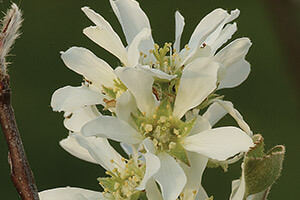
Saskatoon serviceberry, Saskatoon berry, Western service berry, Saskatoon, June berry, shadbush, poirier, petites poires; Cusick’s serviceberry (a particular variety)
Scientific name: Amelanchier alnifolia
Synonyms: Amelanchier cusickii, Amelanchier florida
Origin: The species is native to at least North America
Plant description: Amelanchier alnifolia is a clustered shrub or small tree generally with a height of 2-5m (~ 6.6-16.4ft ). The leaves become glabrous1 or nearly so early in the spring or summer and are broadly elliptical, to a rounded squarish shape to 6 cm (~2.4in) and mostly 1-1.5 times as long as wide. They are coarsely toothed and strongly veined, but are often toothed mainly toward the unattached end.
The flowers are arranged in short racemes2 that are mostly less than 2.5 cm (~ 0.98 in) when in flower and 3.5 cm (~ 1.18 in) when in fruit. The stems of the individual flowers are relatively short, the lower ones at the time of bloom are about 5-10 mm (~0.2- 0.39in). The sepals3 are spreading to curved backwards and range in length from 1.5-3.5 mm (~0,06-9.14 in). The petals are usually 10-20 mm (~0.39-0.08 in) long. The ovary is covered with short matted woolly hairs at its summit. The dark purplish fruits are not quite spherical, are about 1 cm (~ 0.39 in) in diameter, are sweet and are generally thought of as having a good taste.[4]Distribution: The plant is frequently found in thickets, borders of woods and banks of streams.[4] In Canada, Ramsay[11] indicates that the species is tolerant of low levels of sunshine and that native habitats include thickets, borders of woods and banks of streams.
Blooming period: Gleason and Cronquist[4] which covers the northeastern parts of the United States and contiguous parts of Canada, indicates that it blooms in May.
Importance as honey plants: Oertel[7] from his extensive set of questionnaires, found Amelanchier alnifolia to be important in ND, NE and MT and just the genus to be important in IA, OR, PA, WI, WV, MO, UT, WA, AR, KY and MA. Ayers and Harman[1] were not able to distinguish species from their questionnaires, but found the genus to be important in CA, ME, AB, BC and SA. Interestingly, Robinson and Oertel[10] didn’t mention Amelanchier in their ‘Some Important Nectar and Pollen Plants of the United States and Canada.
Ramsay[11], writing about Canadian bee forage, indicates that the species is recognized as a valuable nectar plant in MB, SK and AB, but does not consider it a source of surplus honey. This appears to be from Pellett’s[9] appraisal of its importance in those provinces. Pellett[9] states that the species is generally recognized as of some value to bees, but is probably not a source of surplus honey. He goes on to say that because the species is a very common shrub in the bush lands4, it is more important than Juneberry (probably A. canadensis) in most locations further south. John Lovell[6] doesn’t mention the species.
Harvey Lovell[5] treats only the genus and states that it blooms in early spring and is chiefly valuable for stimulating brood rearing.
Burgett, Stringer and Johnston[3] state that the three species of Amelanchier found in Oregon are “apparently useful to bees only for pollen.” Calling it only Western Serviceberry in their text, Vansell and Eckert[13] state that it was reported to be a source of white honey on the mountain slopes of southern California and the Sierra Nevada at 5000-8000 ft (~1524-2428 m) and in the coastal ranges at 100-6000 ft (~30-1829 m). In their summarizing table, again calling it “Western serviceberry (Amelanchier alnifolia Nutt5)” they do not provide a honey color description and state that its importance for both honey and pollen production is “minor.”
Honey potential: The above suggests that the honey potential is …


